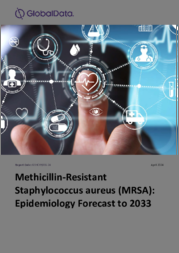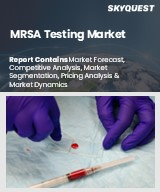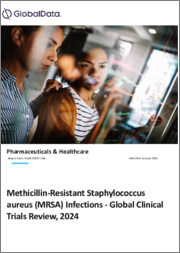
|
시장보고서
상품코드
1473217
메티실린 내성 황색포도구균(MRSA) 역학 분석, 예측(-2033년)Methicillin-Resistant Staphylococcus aureus (MRSA) Epidemiology Analysis and Forecast to 2033 |
||||||
메티실린 내성 황색포도구균(MRSA)은 병원성 항생제 내성균이며, 상당한 이환율로 사망률을 수반합니다(Vazquez-Sanchez 등, 2022). MRSA는 감염한 환경에 따라 병원 및 요양시설에서 발병하는 의료 관련 MRSA(HA-MRSA)와 시중 감염형 MRSA(CA-MRSA)로 분류됩니다(CDC, 2019). MRSA는 특히 감염하기 쉬운 면역부전 환자 및 고령 환자의 증가, 침습수술의 증가, 효율적인 손씻기 및 비필수 카테터 제거 등 감염 대책의 미비 등의 요인에 의해 여전히 유행하고 있습니다(Minnesota Department of Health, 2022).
주요 7 시장(미국, 프랑스, 독일, 이탈리아, 스페인, 영국, 일본)의 메티실린 내성 황색포도구균(MRSA)에 대해 조사분석했으며, MRSA의 위험 요인, 합병증, 세계 동향 등의 정보를 제공하고 있습니다.
목차
제1장 메티실린 내성 황색포도구균(MRSA) : 주요 요약
- 촉매
- 관련 리포트
- 향후 리포트
제2장 역학
- 질환의 배경
- 위험 요인과 합병증
- 세계의 과거의 동향
- 7MM의 예측 방법
- MRSA의 역학 예측(2023-2033년)
- MRSA 입원 증례
- MRSA 입원 증례 : 연령별
- MRSA 입원 증례 : 성별
- MRSA 입원 증례 : 유형별
- MRSA 입원 증례 : 부위 A 감염 유형별
- MRSA 입원 증례 : 부위 A 감염 유형별 - 폐렴 서브타입
- MRSA 입원 증례 : 부위 B 감염별
- 논의
- 역학 예측 인사이트
- COVID-19의 영향
- 분석의 한계
- 분석의 강점
제3장 부록
KSA 24.05.13Methicillin-resistant Staphylococcus aureus (MRSA) is a virulent, antibiotic-resistant bacteria that is associated with considerable morbidity and mortality (Vazquez-Sanchez et al., 2022). MRSA can be categorized according to the setting in which the infection was acquired, as either healthcare-associated MRSA (HA-MRSA), which is acquired in hospitals or in nursing homes, or community-associated MRSA (CA-MRSA) (CDC, 2019). MRSA remains highly prevalent due to several factors, including an increased number of immunocompromised and elderly patients, who are particularly vulnerable to infection, an increase in the number of invasive procedures, and failures in infection control measures, such as efficient handwashing and the removal of non-essential catheters (Minnesota Department of Health, 2022).
Scope
The methicillin-resistant Staphylococcus aureus (MRSA): Epidemiology Report provides an overview of the risk factors, comorbidities, and global trends of MRSA in the seven major markets (7MM: US, France, Germany, Italy, Spain, UK, and Japan).
The report includes a 10-year epidemiology forecast for the hospitalized incident cases of MRSA, segmented by sex and age (0-17 years, 18-64 years, and >=65 years). The hospitalized incident cases are further segmented by infection site (site A infections, which consist of pneumonias, skin and soft tissue infections [SSTIs], and bloodstream infections [BSIs], and other infection sites, as well as site B infections, which included endocarditis and osteomyelitis). Additionally, the hospitalized incident cases are segmented by case definition (HA-MRSA and CA-MRSA) in these markets. The forecast methodology was kept consistent across the 7MM to allow for a meaningful comparison of the forecast hospitalized incident cases of MRSA across these markets.
Reasons to Buy
The MRSA Epidemiology series will allow you to -
Develop business strategies by understanding the trends shaping and driving the global MRSA markets.
Quantify patient populations in the global MRSA markets to improve product design, pricing, and launch plans.
Organize sales and marketing efforts by identifying the age groups and sex that present the best opportunities for MRSA therapeutics in each of the markets covered.
Understand magnitude of the MRSA population by age, sex, type, and infection site.
Table of Contents
Table of Contents
- About GlobalData
1 Methicillin-Resistant Staphylococcus aureus (MRSA): Executive Summary
- 1.1 Catalyst
- 1.2 Related reports
- 1.3 Upcoming reports
2 Epidemiology
- 2.1 Disease background
- 2.2 Risk factors and comorbidities
- 2.3 Global and historical trends
- 2.4 7MM forecast methodology
- 2.4.1 Sources
- 2.4.2 Forecast assumptions and methods
- 2.4.3 Forecast assumption and methods: hospitalized incident cases of MRSA
- 2.4.4 Forecast assumptions and methods: hospitalized incident cases of MRSA by site A infection type
- 2.4.5 Forecast assumptions and methods: hospitalized incident cases by site B infection type
- 2.5 Epidemiological forecast for MRSA (2023-33)
- 2.5.1 Hospitalized incident cases of MRSA
- 2.5.2 Age-specific hospitalized incident cases of MRSA
- 2.5.3 Sex-specific hospitalized incident cases of MRSA
- 2.5.4 Hospitalized incident cases of MRSA by type
- 2.5.5 Hospitalized incident cases of MRSA by site A infection type
- 2.5.6 Hospitalized incident cases of MRSA by site A infection type - pneumonia subtype
- 2.5.7 Hospitalized incident cases of MRSA by site B infection type
- 2.6 Discussion
- 2.6.1 Epidemiological forecast insight
- 2.6.2 COVID-19 impact
- 2.6.3 Limitations of the analysis
- 2.6.4 Strengths of the analysis
3 Appendix
- 3.1 Bibliography
- 3.2 About the Authors
- 3.2.1 Epidemiologist
- 3.2.2 Reviewers
- 3.2.3 Vice President of Disease Intelligence and Epidemiology
- 3.2.1 Global Head of Pharma Research, Analysis and Competitive Intelligence

















